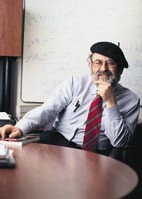- unknown (b.)
Bio/Description
He started out as a Theoretical Mathematician and became a Professor of Mathematics, Computer Science, and Electrical Engineering. He was also a university administrator, the leader of a groundbreaking not-for-profit consortium, and now he is CEO and chairman of a highly successful NASDAQ-listed firm. From his office over Times Square, he presides over AppliedTheory Corporation, his 1996 NYSERNet spin-off. "We provide a wide range of Internet solutions for our business customers, we run research initiatives for NYSERNet, and we provide straight Internet to all the major universities in New York State," he says. "We've grown from five people to 800, and from an annual revenue of $2 million to close to $100 million." In 1985, while he was Vice Provost for Computing and Telecommunications at the University of Rochester, he co-founded NYSERNet, the first nongovernment Internet service provider (ISP). It was an independent, not-for-profit organization representing New York's universities. He is quoted as sayin, "Nobody had really thought out how faculty were supposed to get access to these supercomputers. A few of us at Cornell and Rochester decided it would be very useful if we could reach them using networking technology. So we called a conference of all the major universities in New York State and set up a consortium called NYSERNet, whose aim was to provide the needed networking facilities." The National Science Foundation funded the long-awaited initiative establishing five supercomputing centers for the academic and research community. NSFNet was created to connect these sites to each other. It was incorporated in 1985 as the first Internet service provider (ISP) in the United States. He served as the first Chairman of The Board and Bill Schrader, Executive Director of the Cornell supercomputer center, was its first President. He is quoted as saying, "Bill and I put the organization together, worked the politics, and got members. We set this up as an independent, not-for-profit corporation so that it would have autonomy and be able to represent the interests of the whole university world. One of the significant things we accomplished was getting early cooperation from both the public and private universities, despite the fact that on many issues they were actually at odds and competing for the same funds." NYSERNet remains a not-for-profit research association, although he and Schrader both eventually left to found highly profitable commercial spin-offs. He began AppliedTheory in 1996 and Bill Schrader, went to PSINet in 1989. NYSERNet now has an endowment fund created from its ownership of shares in PSINet and AppliedTheory, which it uses to subsidize the connection fees of its member universities.
-
Gender:
Male -
Noted For:
Co-founder of NYSERNet, the first nongovernment Internet service provider (ISP) -
Category of Achievement:
-
More Info:


